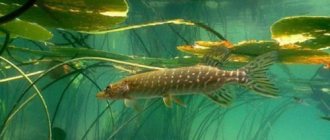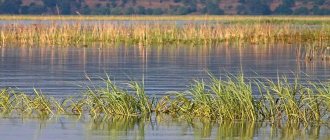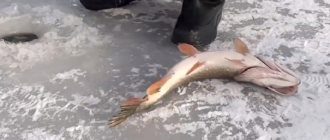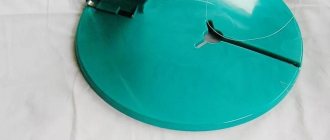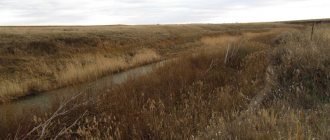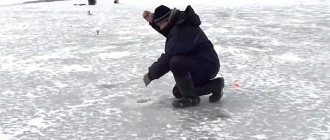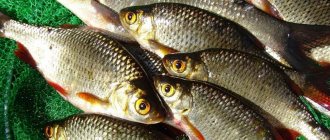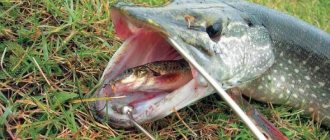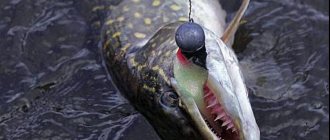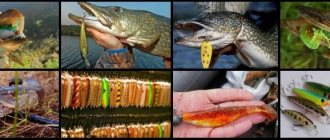Pike can reach a length of more than 1.5 meters, weight - up to 30 kg; females are always larger than males. Pike is one of the most famous river fish. Even an inexperienced fisherman will never confuse it with another fish. Pike is the most popular inhabitant of the waters in fairy tales and legends. Let us at least remember the fairy tale “At the Pike’s Command.”
More articles about pike:
Pike in summer
Pike in winter
Catching pike on a balance beam
The body color of the pike is spotted and striped, with light stripes running along and across the body. Depending on the nature and degree of development of vegetation, pike can have a grayish-green, yellowish or gray-brown color, the back is dark, the belly is white, with gray speckles; silver pike is found in some lakes. The dorsal, anal and caudal fins of the pike are brown with black spots, the pectoral and ventral fins are yellowish-red.
pike spawning
Pike spawning occurs at a temperature of 3-6 °C, immediately after the ice melts, near the shore at a depth of 0.5-1 meter. During spawning, pike comes out into shallow water and splashes noisily. In natural reservoirs, male pike begin to reproduce in the fourth, less often in the third, year of life, and females - in the fifth.
Usually the smallest individuals come to spawn first, and the largest ones last. At this time, pikes stay in groups, 2-4 males per female, and up to 8 males among large females. The female pike swims ahead for spawning, the males swim behind her, lagging behind by about half. The males walk sideways, pushing each other, which is clearly visible in the video.
During spawning, pikes rub against bushes, stumps, reeds and cattails and other objects. The fish do not stay in one place for long, constantly moving around the spawning area and spawning. At the end of spawning, pikes rush in different directions, causing a loud splash, while the males often jump out of the water.
If after spawning of pike there is a rapid decline in water, this leads to massive death of eggs. This phenomenon is often observed in reservoirs during spring level drawdown.
With a length of 12-15 mm, pike fry can already prey on the larvae of carp fish. Spawning of carp fish usually occurs after pike, which contributes to the feeding of pike fry. After the pike reaches a size of 5 cm, it completely switches to feeding on the young of other fish, mainly cyprinids.
In spring, pike enter floodplain lakes along with flood waters. After some time, the connection between these lakes and the river is interrupted, and the life of such pike is strikingly different from the life of its fellow tribesmen in the river or large permanent reservoirs. Due to lack of nutrition, the difference in size between pikes of the same age can reach 2-2.5 times. Small individuals become prey for larger pike; sometimes, with a particular shortage of food resources, pike 3-4 cm long already resort to cannibalism. There are lakes where there is no other fish except pike.
The photo below shows a large pike attacking a smaller pike in a lake where only pike are found.
Where to look for pike in winter
To search for pike, you need to go out to the reservoir only when the ice thickness is at least 8 cm. Only with this thickness or more can you move around the reservoir calmly and safely. Try to carefully examine the body of water before fishing. If the lake is heavily overgrown with vegetation, the lake is closed, has no tributaries, and the water is cloudy, then there is not enough oxygen in such a reservoir. In such lakes, due to lack of oxygen, pike stay at shallower depths.
If there is little vegetation on the lake, and they are deep enough, then there is a lot of oxygen in such reservoirs, and the fish in them stay in deeper places, since there is enough oxygen there all winter even in the deepest places. There is constant circulation of water in reservoirs; the better it flows, the better the water at depths is saturated with oxygen, and this creates better conditions for pike to be at depth.
Nowadays, ice appears on reservoirs at different times every year. If the ice on the reservoirs begins in November, and its thickness should be at least 15 cm, then you can still look for pike in shallow water. And if the ice becomes no earlier than December, then there is no point in looking for pike in shallow waters. At this time, it is better to fish in deep places of reservoirs. You can catch big fish there if you hit the bait in front of the pike. If small fish live at the exit of the pits, then pike will definitely be there.
about pike
A few words about pike. On the hook, the pike desperately resists, shakes its head like a dog, and makes “candles.”
But how many pleasant experiences, how much adrenaline such a fight brings! And if the pike is caught, and even if a strong fish breaks loose and deservedly gains the desired freedom, the fisherman will still never forget the minutes of the wonderful fight. That's why fishermen love to catch pike. That's why they appreciate her. And when it comes to pike, no one remains indifferent.
It is known about pike that it can eat a wide variety of foods: fish, including its own young, frogs, small rodents. A relatively large pike is capable of dragging a duckling, a baby muskrat or a water rat underwater and swallowing it. It happens that by autumn, pikes eat up everything living and at least somewhat attractive in the lakes, and, hungry, they eat water snails. They collect them clumsily, but with enviable tenacity; in a day they fill their stomachs with heavy food so much that they then swim with difficulty.
Often a pike grabs prey that is not much smaller than its own length. The pike cannot swallow it right away, nor can it bite off a piece, so it has to digest the victim gradually. While the prey's head is being digested in the pike's stomach, the tail sticks out from the toothy mouth. But the point here is not at all about pike greed, but about the structure of the pike’s teeth.
Winter fishing for pike
Ice fishing for pike differs from the open water season in the behavioral characteristics of this predator. If in summer and autumn the toothy fish thrives, greedily attacking unwary fish, then in winter it experiences harsh times. Accordingly, pike activity during this period is lower. The habits of toothy fish in winter directly depend on external weather conditions, the oxygen content in the water and the location of the forage fish.
- There is no need to look for short and unpredictable exits, when the predator grabs everything that moves in the water. First of all, the pike is not a raider, but an ambush hunter. Therefore, the point of search tactics during fishing is to find such an ambush.
- With the passage of time and changes in the environmental conditions of the reservoir, the toothy fish changes its location, but the principle of hunting remains the same. The pike stands still or slowly cruises in a certain square, making short and quick throws at the target of attack.
- The behavior of pike in winter is cyclical - the harsher the conditions, the more passive the fish. But even in the most unfavorable times, the predator continues its hunt as usual, it’s just that everything happens slowly and sluggishly.
- Pike conserves energy as a cold-blooded animal; it simply cannot act fiercely and quickly in low temperatures. When fishing in winter, you need to understand these features and not rush when fishing, act measuredly but correctly.
Important nuances of fishing
- Some fishermen are interested in when the pike gets hungry in winter. There is no separate winter pike meal as such. But you can get to the end of the autumn season on the first ice. Towards the end of winter, activity also begins, but this is not zhor. Also, short periods of relatively high activity can be observed in the dead of winter during long thaws (more on this later).
- When does a pike change its teeth in winter is a common question. Throughout the year, gradually, but most actively after spawning. Moreover, this moment occurs differently in specific individuals. So this is not a bite factor at all.
- You should not trust various pike fishing calendars - they are not objective, they only reflect a general theoretical trend. Each body of water (and large ones - in a section of the water area) has its own schedule at different times. It is better to study the trends in the general behavior of the predator, then conduct observations on a specific body of water during the season. Only then will it be possible to confidently know how a pike bites, and only in this place.
- The pike bite in winter is unpredictable. In the most unfavorable conditions you can catch a good fish, but in ideal conditions you can be left without a catch.
- In winter, it is important to reduce the overall speed and intensity of fishing. If in the summer, especially during exploratory travel fishing, everything happens quickly (2-3 casts, transition), then in the winter you need to wait for the slowed-down predator. Therefore, it is important to choose the right fishing location in advance.
Early winter
During a sharp cold snap “already in winter,” which ends with the formation of ice and the cessation of fishing in open water, there is a certain decrease in the autumn hunger for pike, which turns into early winter. This happens because the predator needs some time to adapt to new conditions. Pike in the first ice are, in principle, active - the fish devotes all its energy to storing nutrients for the winter. As soon as the ice is established, the banquet continues.
On the first ice, in November and December, fishing for this fish in winter is very successful. The toothy one pirates in coastal shallows, dumps, edges - almost everywhere. When fishing on clean, transparent ice, you need to move carefully and not make noise - fish can easily be spooked by noise or flickering light and shadow. It’s good if the surface is dusted with snow - the pike’s caution in this case drops. At this time, any pike tackle and bait work.
Glukhozimye
By January, water temperatures drop and oxygen levels drop. In the wilderness, the predator gradually goes deeper and feeds less often and less. But this does not mean that the pike does not feed. She just does it less often and acts slowly, passively. The best way to fish in January is with special girders for deep winter. The structure of the equipment is the same, but thin fishing lines are used.
A metal leash reduces the number of bites significantly, so experienced garrison fishermen do not use it when fishing in the dead of winter, putting up with rare breaks in order to increase the number of bites. By the end of the month, February pike is being caught better - pre-spring changes are felt.
During prolonged thaws, pike can become more active and hunt, even going to depths of less than half a meter. This is due to meltwater getting under the ice and increasing oxygen levels. In small rivers with a large number of springs and gullies on the rifts, the toothy one remains relatively active all winter.
End of winter
Towards the end of February and in March, the toothy activity increases again. Accordingly, on the last ice it is caught well everywhere, including in shallow water. In spring, small baits, live baits or spinners are used for fishing, since it is difficult for fish to push large objects through the digestive tract (due to the development of eggs and milk). Artificial baits are back in business.
river pike and grass
river pike
Among pikes living in Europe, anglers distinguish two varieties: river pike and grass pike (or lake pike). River pike is shorter and more powerful than grass pike. As a rule, river pike (with the same length) is thicker than grass pike, which has a narrow and long body. In addition, grass pike is lighter than river pike; green tones predominate in its color.
grass pike
River pike is golden, with rare dark olive stripes or spots. But the color of pike is not always constant, and can change depending on its habitat, the color of the environment and the light. As a rule, young grass is lighter and brighter than its older brethren. And the fry of river pike and grass pike look exactly the same, and only over time, under the influence of different living conditions, do they acquire a characteristic color and shape.
Pike does not like fast currents, and always prefers quiet, calm creeks and bays. For herbaceous plants, problems with choosing housing usually do not arise. But fairway pike are forced to move all the time and hunt a lot. Therefore, river pike is both more powerful and hardier than lake pike.
The pike very rarely pursues its prey; usually it overtakes it with one lightning-fast throw. If the prey turns out to be small or if the pike misses, then it returns to the ambush and patiently waits for the right opportunity for the next attack. River pike often chase food; grass pike do this either during periods of gluttony or when there is a shortage of food. By nature, the herbalist is a homebody. She can live in the chosen area all her life, leaving for a short time and, if possible, nearby. A weed grass can leave its favorite whirlpool or bay only when its habitat conditions suddenly change.
Can large pike be caught on dead fish?
Pike fishing in the fall can yield large specimens. Most often this happens in November. But when choosing this fishing method, you need to understand that large pike are looking for food at the bottom, which means that the gear must be such that it can easily deliver the bait to this part of the reservoir. In addition, it is better to choose the most durable gear, because large fish have much more strength, which increases the risk of damage to the rod.
Effective ways to catch pike
There are a large number of ways to catch pike. The choice depends on the fishing season and the desired result. The most effective are:
- spinning fishing from the shore or boat (in this case, any bait can be used), including spinners;
- fishing with live bait, including using special circles;
- float fishing with live bait from the ice until the end of March.
pike fishing
Pike fishing is varied, using any bait and all sorts of methods. When catching pike with a spinning rod from the shore or from a spit, they often use spinners, mainly spinners. The best results when fishing for pike are provided by MEPPS spinners that have been proven over the years, such as “ Aglia ”, “ Aglia long ”, “ Thunder-bug ” (thundering beetle). But this is not a fact that “oscillators” like “ Syclops ” will be worse at catching pike.
Mepps spinners
- Aglia
- Aglia long
- Thunder bug
- Syclops
In places where conditions permit, good results are achieved by fishing for pike with live bait. In quiet pools and bays you can catch pike using a sinking wobbler or a large (10-17 cm) vibrating tail. How, and which baits are clearer and more convenient for the fisherman, are the ones used to catch pike. With the exception of live bait, the rest of the baits are approximately the same in their catchability. It is necessary to catch pike with live bait only in cases where the angler knows exactly where it is standing.
When fishing for pike from a boat by trolling, the most effective bait is a tackle with a large bleak. However, trolling is more often used to catch pike using a wobbler. In sections of the river with a slow flow and bays, you can attach a loach, gudgeon, minnow to the tackle, or even replace the fish with a light (white or yellow) twister.
catching pike on a rig with fish
pike fishing tackle device
There are two ways to catch pike with a tackle: active and passive.
The active method is very similar to fishing for pike with a spoon. From a boat anchored or drifting with the current, the fisherman casts the bait either towards the shore or towards the fairway (but always across the current) and, when the sinker falls to the bottom, begins to reel in the fishing line, using step-by-step retrieval, as when fishing for pike on jig.
Select a sinker depending on the depth of the reservoir and the strength of the current, but preference should be given to the lighter one. Install it at some distance from the tackle, usually 25-40 cm from the nearest hook. When using not very large live baits for pike fishing, it is better to use soft tackle, consisting of two or three single hooks No. 12-16.
The passive method is similar to trolling (or trolling) for pike, and to be precise, this is trolling. But in classic trolling for pike, a wobbler or a heavy spoon is used, and in our case it is a tackle with a fairly large live bait or dead fish. In this case, the tackle itself is not loaded, and the length of the leash is selected depending on the strength of the current and the size of the bait or fish. The stronger the current and the smaller the bait, the longer the leash should be. But in any case, the length of the leash should not be less than 50-75 cm.
The gear looks somewhat different if the bottom of the reservoir is clean and the bait can be dragged along the ground. A tackle (usually rigid) with a sinker installed at the head of the fish is attached to the main fishing line. Some fishermen advise cutting off the fish’s head altogether and installing a sinker in its place.
Having lowered it to the bottom, install the spinning rod so that about a quarter of its upper part protrudes beyond the stern of the boat, and the handle and reel are next to the angler. Then, after making several powerful strokes, release the line until it is located at an angle of 45-60 ° to the surface of the water. After this, close the reel line handle and reduce the speed of the boat to a minimum. Point the boat against the current or across it, carefully watching the tip of the rod, and at every suspicious “nod”, make a wide and powerful hook.
First of all, fish the coastal edges, backwaters, and channels between the islands. When you have to guide the rig in areas with sharp changes in depth, replace the sinker with a lighter one and increase the speed of the boat. In this case, the lightweight tackle rises closer to the surface. So, by accelerating and slowing down the movement of the boat, change the fishing depth.
The bite of a pike with this method of fishing is determined by a change in the movement or tension of the fishing line. Sometimes the line goes to the side, down or under the boat. Having noticed this, the fisherman needs to put the oars on board, take the spinning rod in his hands and release the line, giving the pike the opportunity to reliably swallow the bait without experiencing resistance. And only after 10-15 seconds you can pick up the slack and make a sharp hook.
catching pike with a spinner, wobbler, vibrotail, foam fish
Catching pike with a spoon and its variants, such as wobblers, vibrotails, twisters, and foam fish, is the most common type of fishing for this predator. In general, spinning is the most popular type of fishing, which also has supporters among women, as in the photo. Throughout the summer, lovers of pike fishing with spoons, wobblers, vibrotails and other artificial baits can successfully catch pike where other river fish (crucian carp, bleak, bream) stay for a long time. Naturally, the probability of catching a large pike in such places is small, but medium-sized pike are caught here all the time.
On fine warm days, it is better to catch pike either early in the morning or in the evening, when the sun drops to the horizon. When it gets colder, pike can bite all day long. Any bait that can catch you: spinners, wobblers, vibrotails. The main thing is that they are not too large. For catching pike with lures, “spinners” and light, narrow “oscillators” such as “Syclops candles” from Mepps are most suitable.
Wobblers for pike fishing are suitable for any type, with a length from 3 to 10 cm. Vibrating tails should be approximately the same size.
On clear sunny days, pike are caught with dark spinners and wobblers, and in cloudy weather, shiny (preferably golden) spinners and white or yellow vibrating tails are required. In calm weather, floating or slowly sinking wobblers are the most catchy.
The tactics of fishing with artificial bait in places where peaceful fish accumulate has its own characteristics. First, the fisherman fishes the coastal zone to his right and left. In this case, the casting distance should not exceed ten meters. Usually the spoon is cast two or three times in one direction. Then more distant areas are fished..
At the end, they perform a series of casts straight ahead, throwing the spoon 30-40 meters. To fish the entire area, it usually takes about 30 casts. If there are no pike bites, it is better to change the fishing location.
However, when the angler is sure, or at least guesses, that the pike is somewhere nearby, it makes sense not to be lazy and, after replacing the bait, repeat the whole cycle again, changing the game of the bait.
It happens that very small squirrels overwhelm with bites. In this case, it is better to stop fishing for pike in this area and look for another place. The fact is that small pike never hunt where large pike stand.
FOR THE TROPHY!
Give recommendations for catching large pike that would be suitable for all occasions. - an empty matter. In more than thirty years of experience, I have never had two identical fishing trips. Similar - yes, but absolutely identical - no. Every time you have to adapt to a new situation, change something all the time, and sometimes even invent. And all this until you find the right solution and get the desired result. Therefore, my thoughts are only a general overview, so to speak, and advice is nothing more than wishes. Whether to agree and follow them or not is a matter of everyone’s taste.
Therefore, I will try to go from the opposite and limit myself to this. which, in my opinion, should not be done when fishing for large pike. There are quite a lot of such moments, but the size of the newspaper page does not allow us to list and explain them all.
For example, you should not use sinking and neutral wobblers in snags - you are guaranteed to “plant” the bait. And irrevocably. It is better in such places to use a floating wobbler with a working depth of 1.5-2.5 meters. Wiring should be slow and careful. At the slightest obstacle to the wobbler, loosen the line by tilting the tip of the rod. If it’s a bite, the pike will hook itself, and if you feel its live resistance, make a control hook. At the same time, there is a chance that the second (third) tee of the wobbler will grab it for something else. If it is a snag, loosening the fishing line will allow the wobbler to float up and safely bypass the obstacle.
Wobbler without tees
Never start “combing” a hole or pool with full-fledged bait. First try to “test” it with a small spoon without a tee. This will not scare the pike, but you will be able to clearly determine whether there are hooks there or not. In the hole you need to cut quickly and hard. The risk of losing the bait is, of course, high, but without hooking, there is an even greater risk of missing the fish. There's nothing you can do about it. If the bait is very dear to you, don’t fish in the hole at all.
Never move the bait as if your main goal is to quickly pull it out of the water. A reputable pike will never rush after a spinner flying past at breakneck speed. For what? She would rather wait until someone sick or careless comes within range of a calm and confident throw.
When fishing for prey, do not back away to the shore far from the water’s edge, and when pulling out, never grab the fishing line or leash with your hand—breaking the tackle or losing the fish is almost guaranteed.
When biting a large pike, do not force the fish. Let her do a few laps. Large pike (unlike small ones) almost never get caught in snags; they are quite confident in their abilities. When the fish moves away from you, slowly tighten the brake; when someone approaches you, let go. But never give in to slack: this can lead to a collapse, especially when you are fishing with a jig.
a pike weighing more than five kilograms on board is very problematic, even with a hook or landing net, but it is impossible to lift a pike weighing ten kilograms. If there is no assistant nearby, do not despair. Loosen the brake almost to neutral, start the engine and slowly tow the pike to the shore. There you can easily handle it.
Finally, a video about catching trophy pike:
fishing for pike
You need to catch pike using a landing net or hook. If you do catch your first pike and you don’t have a landing net or hook at hand, don’t rush to grab it with your hands. The pike will still break out, injuring your hand.
The most reliable way to get a pike out of the water with your bare hands: bring the fish to the shore (to the side of the boat), press the pike's eyes inside the skull with your thumb and forefinger and calmly pull the pike out of the water.
To avoid injury, you need to remove the bait from the pike's mouth using an extractor. A yawner will help open the pike's mouth.
- Zevnik
- Extractor
About fishing line and leash for winter pike fishing
Winter pike fishing takes place using monofilament. Firstly, because of the low temperatures, and secondly, its tensile properties will only help fishing. It either speeds up or slows down the movement of the bait, depending on the thickness of the fishing line. But it is best to take a fishing line with a diameter of 0.2 mm; it is quite enough to pull out pikes weighing up to 3 kg. You can keep a second fishing rod in reserve with a thicker line, in case you plan to cast in snags or catch a trophy specimen.
As I already wrote, it is better to use balancers no more than 5 centimeters. I rarely use a leash, practice shows that it is better to sacrifice a pair of balancers, but gain in the number of fish caught, and the pike usually grabs from behind or from the side, and rarely reaches the head of the bait. Or you can use a fluorocarbon leader. It is invisible in the water and much stronger than fishing line. If you catch a large pike, do not rush to pull it out right away, let it make a few jerks on the line. Then you can slowly pull it out of the hole. I use swivels to quickly change baits.
Also watch a video about winter pike fishing:
To Home Page.
